Case studies
Industries
Resources
TikTok Collection
NEW
Table of Contents
In case you haven’t noticed, content marketing has evolved.
Big time.
Far gone are the days of text-only blog post and spammy article directories. Modern eCommerce content marketing is about crafting various forms of creative, compelling content in hopes of attracting new customers and clients.
While uncovering new business is at the forefront of any eCommerce brand’s marketing efforts, content creators must understand the wants and needs of today’s consumers. Among those desires, perhaps three most important include:
In short, modern content needs to be quick to digest and easy on the eyes, all while maintaining a voice that speaks loudly.
With fierce competition and so many options available when it comes to what we create and how we share it to the world, brands are tasked with working smarter rather than harder when it comes to content creation. By understanding the following eCommerce content marketing strategies, you can emphasize your brands’ strengths and put your business on a pedestal to pull in potential clients.
Blogs are far from a dying breed: if you’re looking to grab the attention of potential customers and make the most of your SEO efforts, you’re going to need a killer on-site content. The question remains: what pieces of content will speak most to visitors? Consider the following as a solid starting point for a livelier, creative blog that drives conversation amongst your audience.
Find out how to craft the perfect instagram caption for your eCommerce photos.
Storytelling represents the secret weapon of budding brands looking to get noticed; likewise, anyone can share their humble beginnings regardless of their niche of industry. The benefits of storytelling content are three-fold, as personal pieces…
There is blanket approach to storytelling content; however, chances are you already have everything you need to get started. How so?
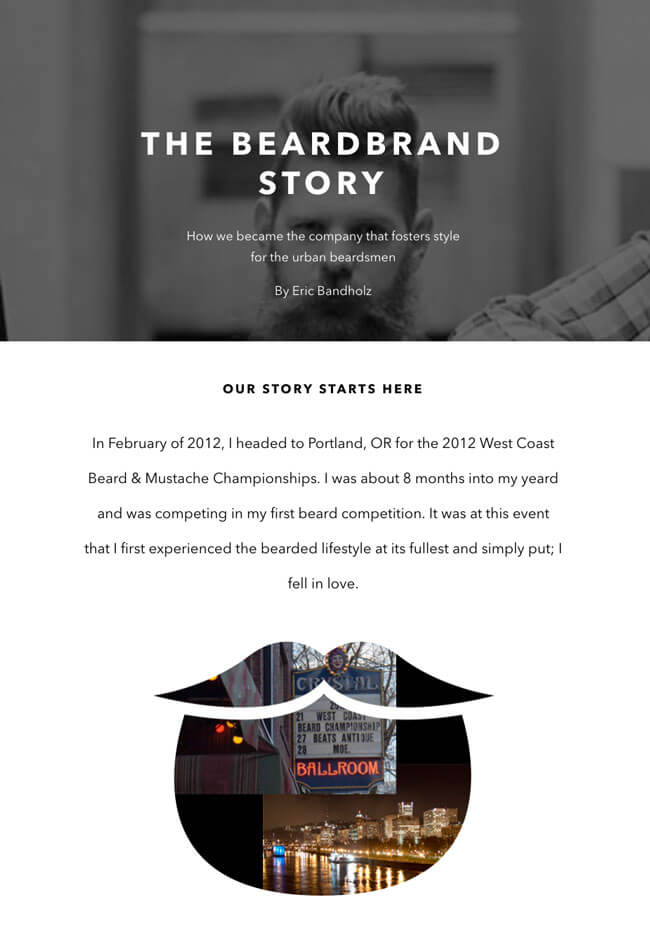
Most modern brands rely on killer “About” pages to tell their stories and help clients understand their humble beginnings. Beardbrand founder Eric Bandholz went from just another dude in a local beard competition to owning a seven-figure grooming business by following his heart. At their core, brands represent people: by taking the time to explain where you come from and how you got to where you are to today, your customers will be able to relate accordingly.
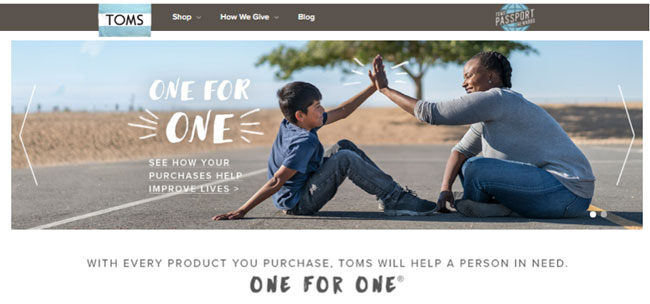
Beyond your story, your vision or mission statement can speak volumes regarding what your business is all about. For example, Toms is more than just another shoe-seller: for every pair sold, the company works to improve the lives of those in impoverished countries. Toms’ vision statement is front and center of the brand’s content efforts, from images of those affected by poverty to blog posts following the journeys of local customers who give back to their communities.
Storytelling doesn’t have to be a “one and done” content marketing tactic. Clients and customers want to follow brands they can relate to; therefore, more often you can tell your story and blog your journey, the more likely you are to amass a following that’s hungry to hear about your progress.
Modern brands and customers thrive on reviews.
Reviews can help us drive targeted traffic with specific intent, while also representing a potential goldmine for SEO. If someone is searching for “monthly geek subscription box reviews,” they’ve expressed their intent to buy into such a service; likewise, such long-tail keywords represent low hanging fruit for future content.
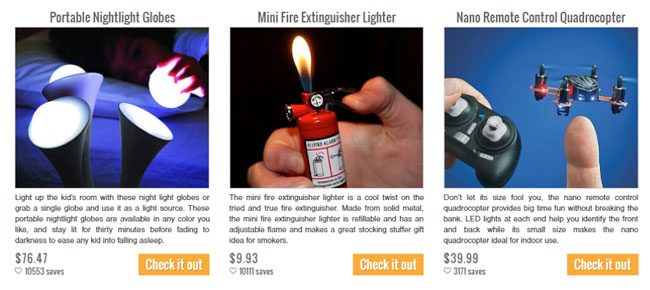
For example, sites such as This Is Why I’m Broke highlight hot products and reviews to pique the interest of readers and drive sales. Considering that approximately 77% of consumers read reviews before making a purchase, brands should strive to harness the often-untapped power of reviews.
On the flip side, brands also leverage reviews and testimonials about their own products to drive new leads. After all, reviews can help break down the trust barrier for skeptical buyers and prove that your brand is already home to satisfied customers. Using ridiculous, rave reviews from Amazon, Death Wish Coffee crafted a hilarious blog post detailing customers’ experiences with their self-proclaimed “world’s strongest coffee.”
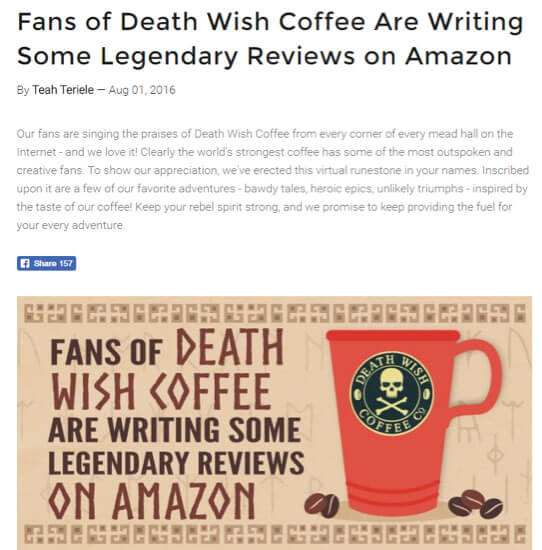
If you have advocates for your brand, either past clients or current customers, considering leveraging their testimonials and feedback for future blog posts. You could ever take their experiences and turn them into a storytelling post, such as how your product helped them solve a problem or experience something new.
In short, sometimes our best cheerleaders are our own satisfied customers.
How-to articles are time-tested cornerstones of any effective content marketing strategy.
The benefits of how-to content are well documented, including:
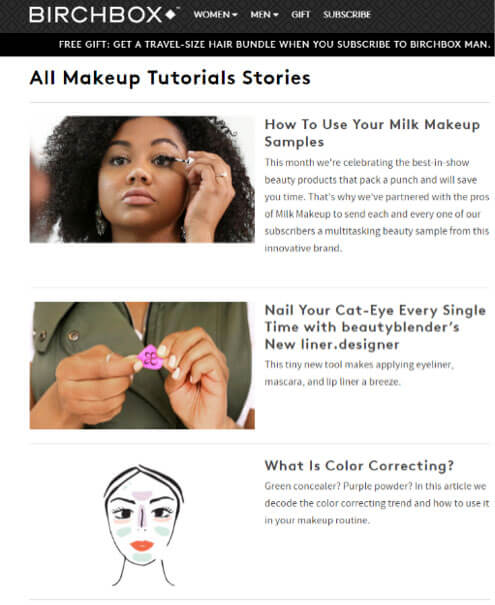
If you’re strapped for ideas, start by considering the pain points of your audience and what sort of questions they need answers to. Ask yourself: what’s going to relieve their stress, save them money or eliminate needless tasks from their daily routine?
Ideally, you can incorporate your own products into your how-to content. For example, beauty subscription service Birchbox produces regular how-to blogs concerning applications of their various make-up. Such content serves as a sort of exercise in copywriting for your own business, naturally selling yourself to customers seeking help.
But remember: eCommerce content marketing doesn’t all have to be about the sale. Naturally educating our audience is a valuable form of influencer marketing strategy that builds the value of a brand for the long haul.
Modern brands have the opportunity to leverage numerous types of content: by varying your strategy with pieces surrounding storytelling, reviews, and how-to’s, you open new doors for your audience.
Social media is a critical component of marketing for eCommerce sites. Specifically, visual content is taking the social sphere by storm: the more images and videos you can create surrounding your brand, the better. UGC platforms such as Flowbox help you integrate your clients images into your eCommerce.
But the wealth of social sites out there creates a conundrum for brands: that if, where should we focus our efforts and what kind of visual content best suits our business? While the answer may vary based on your industry, products and resources, consider the following as a solid starting point.
As noted earlier, video marketing has perhaps experienced a boom like no other in the marketing world. With millions of hungry viewers providing YouTube with over five billion views per day, there’s little doubt that more and more brands will continue to hop on the video bandwagon.
While video marketing may have been perceived as costly and difficult to manage a decade ago, modern brands are tapping into simple, straightforward videos which cost them little more than their time and a smartphone camera.

In fact, many of the aforementioned on-site content strategies can be employed via video, such as:
Keep in mind that eCommerce content marketing on YouTube doesn’t have to be an incredibly elaborate affair. The most-viewed videos on YouTube are below two minutes in length, signaling that a short and sweet, less is more approach to vlogging may be the best bet for most brands. Most importantly, think of your videos as a legitimate dialogue between your brand and its base. The more genuine value and personality you put into your videos, the better.
Here’s the thing: According to statistics, including a video on your landing page can increase conversions by more than 80%. Video may be uncharted territory for your brand; however, the ROI and importance of video to modern consumers is becoming increasingly difficult to ignore.
Instagram has proven to be an expectedly powerful marketing tool for savvy companies looking to leverage imagery in their marketing. Likewise, eCommerce brands are especially ramping up their Instagram ad spending in an attempt to reach the platforms user base of over 1 billion. The beauty of Instagram is that it’s a visual content double-threat, allowing brands to leverage both photos and video.
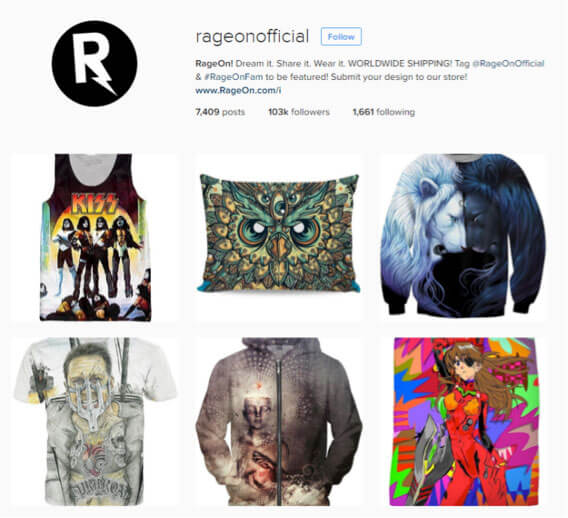
The diversity of Instagram is easy to miss for marketers who only pay attention to selfies and celebrity photos. There are many ways of encouraging consumer generated marketing, including:

Instagram represents a breeding ground for User Generated Content, which can in turn grow your brand’s exposure and lower your customer aquisition cost. Having our fans and followers is more than just icing the cake for today’s brands: the more followers we have singing our praises and sharing our products, the less legwork we have to do as content creators.
Related reading: eCommerce Conversion Rate
As our followers’ feeds can get quite crowded, make sure you put out the best of the best when it comes to imagery. What’s going to grab someone’s attention, make them stop what they’re doing and hit “Like?” Each post should have a purpose, whether it’s to get people talking or simply let followers know that you have a new product on the shelf.
Platforms such as Pinterest and Tumblr are often considered secondary social channels for eCommerce, although they may valuable sources of untapped customers and traffic. Considering that Pinterest represents the number-two traffic source for all Shopify sites, there’s most certainly gold in the proverbial hills if you’re in the right niche. Although Pinterest and Tumblr aren’t as focused on B2C relationships versus other social sites, they are home to a wide millennial audience interested in imagery.
While most brands aren’t going to break the bank on secondary social sites, you can repurpose existing content and expand your following accordingly. For example, Pinterest and Tumblr are hubs for visual content such as:
Infographics – Quick and simple to understand at a glance, infographics are visual representations of written content (such as case studies or industry data) may be more accessible for our audience versus a long-form piece.
Listicles – Sites such as Buzzfeed have popularized lists, which are also extremely easy to digest; likewise, the simple nature of lists make them prime for social sharing.
How-To’s – Once again, how-to’s rear their head, signaling the need for today’s brands to everything they can educate their audience. Whether it’s how to start a money-making blog or tips for a DIY project, consider that our customers are constantly scrambling to ask questions online: the more answers you can provide, the better.
Grabbing the attention of your audience through visual content is about more than just stock photos and fluff, but rather providing value and something that’s, quite simply, worth talking about.
eCommerce content marketing takes many shapes and forms for modern brands. In fact, the wealth of options out there can be downright overwhelming for budding businesses looking to put themselves out there.
Regardless of what you choose to do, understand the emphasis on visual content and personalization as a means of reaching modern customers. Your followers don’t want what they’ve seen a million times before: they want to see fresh content that doesn’t feel like a waste of time.
By creating content that’s quite literally worth seeing, you can ultimately build a brand that stands the test of time.
Which pieces of content are garnering the most buzz for your brand? Any social networks you’re still trying to break into content-wise? Let us know in the comments below.